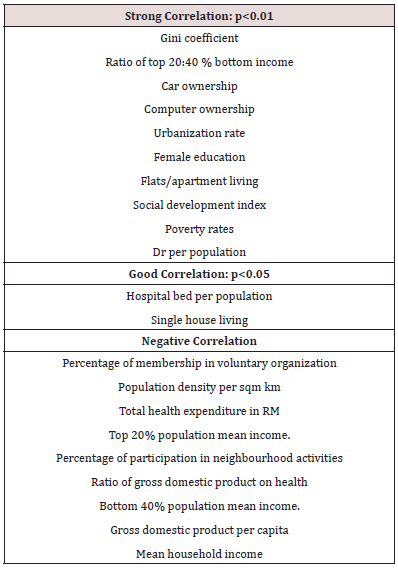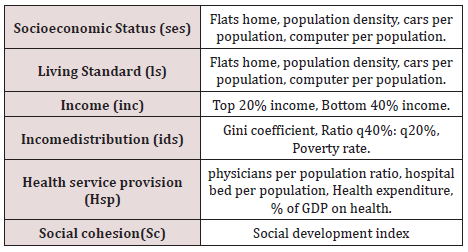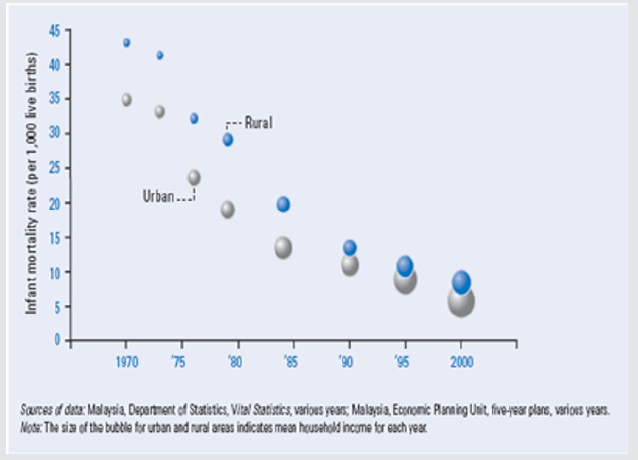
Lupine Publishers Group
Lupine Publishers
Menu
ISSN: 2690-5760
Research Article(ISSN: 2690-5760) 
Social Determinants of Infant Mortality in Malaysia Volume 2 - Issue 4
A Amaluddin1* and N Spencer2
- 1Asia Metropolitan University, Johor Bahru, Malaysia
- 2Warwick Medical School, The University of Warwick, UK
Received: November 13, 2020 Published: February 22, 2021
Corresponding author: Amaluddin, Asia Metropolitan University, Johor Bahru, Malaysia
DOI: 10.32474/JCCM.2021.02.000148
Abstract
There is a large body of empirical evidence to suggest that social conditions are one of the major determinants of population health. These are defined as the ‘Social Determinants of Health (SDH)’. SDH refers to the specific pathways by which social forces affect health. This study aims to examine the relationship between social determinants and infant mortality in Malaysia. The methodology comprises of an ecological (area-based) population health survey involving all 135 administrative districts of Malaysia. Statistical analysis using general linear model including correlations, factor analysis and multiple regression were undertaken in order to examine the influence of determinants on variations observed in Infant Mortality Rate (IMR). Simple regression revealed significant relation between IMR with fifteen predictors, but multiple regressions failed because of multicollinearity among variables. Factor analysis was done to identify similar items. With the new group of variables, economic development explained 27%, socioeconomic status explained 21%, income inequality explained 14%, service provision 9% and finally type of housing explained 4% of the variability observed in IMR. . One unit increase in living standard would reduce IMR by 1.6 while a unit increase in income distribution would increase IMR by 0.9. In conclusion, developing a better understanding of the social determinants of IMR is critical in order to ameliorate the social determinants associated with poor health and to reduce the health disparities within the population.
Introduction
Background
Currently, there are already good empirical evidence to suggest that social conditions are one of the major factors affecting population health[1]. These are defined as “Social Determinants of Health (SDH)” [2].
Aims
This study aimed to examine the relationship between social determinants and Infant Mortality Rate (IMR) in Malaysia. It sought to identify social determinants that could possibly influence the observed differential in Infant Mortality Rates (IMR) between the Malaysian districts.
Literature Review
Developing a better understanding of the Social determinants of health is critical in order to ameliorate the social factors associated with poor health and reduce health disparities within the population [3]. Many developing countries have experienced poor child health status reflected by high rates of IMR alongside slow progress of IMR reduction [3]. Malaysia had experienced dramatic improvements child health status reflected by reduction in IMR during the latter part of 20th century . The IMR in Malaysia dropped from 178 in 1929 [4] to 75.5 in 1957 and to 6.4 per 1000 live births in 2010 . Not much is known from Malaysian literature to enable comprehensive understanding of the influence of social determinants on infant mortality, especially in terms of explaining the inequality and variability of IMR observed among different segment of the populations. The wide difference of IMR between the rural and urban communities is very noticeable. Urban districts demonstrate much better child status with mean IMR of 8.87 with confidence interval at 95% between 7.7 and 10.6 while IMR for rural area were 10.2 with confidence interval at 95% between 8.8 and 11.5. The difference between two means was statistically significant at p<0.05 level with confidence interval of (-2.27 to-0.32) [5].There are 9.3 million or about 44% of the Malaysian population reside in rural areas. Living in rural areas poses a disadvantage when it comes to healthcare. Despite the extensive government effort, there is still a difference in infrastructure and health care delivery between rural and urban communities [6].
Insights into the change in IMR patterns in Malaysia has been previously described. Yadav (1986)[7], for example, described falling trends of IMR in one of the most densely populated districts in the state of Perak (Kerian) which covers an area of 184 square kilometers. The population consists of 65% Malays, 22.4 % Chinese and 12.3% Indians besides other races. It was classified as one of the rural districts (with an urbanization rate of 26.4%) and main occupations were farming, fishing and rubber tapping. Infant mortality declined from 40.52 per 1000 live births in 1970s to 6.3 in 2001.This constitutes an almost 60% reduction. In a comparative study, [8] detected that there is a significant change in IMR in both rural and urban areas from the early 70’s till 2000. Figure 2 presents the mortality rate of infants in the urban and rural areas of Malaysia from past decades to year 2000. Analysing the figure below, Lek [8] concluded that there is a slow progress in reducing infant mortality in Malaysia especially in the rural areas during the early 1970s. However, the result later showed a very visible improvement especially during the 90’s in which the reduction of infant mortality rate in rural areas was no longer far from the reduction of infant mortality rate in urban areas. One key reason postulated for the higher mortality rates in the rural areas was the low social status especially when living in poverty even within a rich country[9]. Zulkifli et al.[10] suggested that the way forward to improving Malaysian population health status is by further research into factors contributing to enhancement of health among the disadvantaged groups and reduction of health inequality between the rural and urban populations.
Materials and Methods
The methodological framework to investigate Social Determinants (SDH) of IMR in Malaysia as proposed in this study is based on the WHO Equity Team SDH framework (2005) and supplemented by the framework for the study of the determinants of infant survival in developing countries as suggested by Mosley and Chen [11]. Their approach was that social determinants of child mortality operate through a set of determinants (social variables) to exert their impact on the health outcome.
Data Sources
The current study is underpinned by the following approach. First, a measure of population health status was identified. Infant Mortality Rate (IMR) was chosen in this case because very good area base data on IMR existed in Malaysia and were readily available. Next, a review of local and international literature on social determinants of the IMR was undertaken to identify possible determinants that affect infant mortality. Data was then collected on indices representing those social determinants which includes basic amenities, mean household income, income distribution, top 20% income, bottom 40% income poverty rates, Population density, education status, health services, employment status, housing types.Health service provisions e.g. population per doctor and hospital bed to population ratio, health expenditure, GDP per capita, Gini coefficient, poverty rates, urbanization rate, cars per population, computer per population, social capital.
Analysis
The data were then analysed to determine the degree of association of the identified variables with the IMR. Statistical analysis of infant mortality and social determinants data using correlations, factor analysis and multiple regressions were undertaken in order to examine the collective influence of a range of social determinants indices on variations observed in infant mortality. Although simple regression later revealed significant relation with fifteen predictors, further analysis using multiple regressions failed to demonstrate any significant linear relationship possibly because the items suffer from the threat of multicollinearity.
Further Analysis (FA)
Factor Analysis (FA) was performed to address the problem of multicollinearity. Extraction by component analysis estimates the ‘eigenvalues. Factors with eigenvalues above 1 are considered significant factors.In this analysis there were 6 factors with eigenvalues >1 with cumulative percentage of 87.3% capacity to explain the total variance observed among the independent variables. These factors are socioeconomic status, living standards, household income, income distribution, and social development index and health service provisions.
Results
With these 6 groups of new variables (table3) demonstrated that 3 variables demonstrating significant determinants of infant mortality at p< 0.05 level. This includes socioeconomic status (Beta=, p<0.0, R²= 0.03), income distribution (Beta= 0.325, p<0.001, R²=0.11), social development index(Beta=-0.425, p<0.001, R²= 0.18). Living standard (Beta=-0.131, p=0.13, R²= 0.02),income (Beta=-0.113, p=0.19, R²= 0.013), and health service provisions (Beta=-.196, p=0.02, R²= 0.038) demonstrate less significant regression with p=>0.05.The with all the six factors only explained a total of 27% of variability observed in IMR.
Discussion
Study reflect that, socioeconomic developments still play an important role in reducing infant mortality differentials with 27% explanatory power in the regression analysis with IMR. development alone has ceased to be an important variables that also determine IMR differentials are income distribution (10.6 %) and social development index (18%). This finding is consistent with the studies reviewed in the [12]. For a developing country like Malaysia, socioeconomic status is still an important determinant influencing IMR. This factor reflects education level, per capita GDP and urbanisation rate. Income distribution as an important determinant has long been established. Hales et al., [13] for example, stated that IMR was negatively associated with GNP per capita but positively associated with income inequality.
The policy changes that may contribute to reduction of infant mortality and improvements in child health should not be a focused only on raising socioeconomic status but more importantly to narrow the income gap between the top 20% income earners to the bottom 40% income earner in order to improve income distribution. Social capital also appears to be an important determinant of IMR in this study. Sustainable Development Goal (SDG) set by the UN, particularly WHO, in order to benchmark its achievement. The aim of SDG on health, among others, is to be able to achieve more equitable and sustainable low mortality rate among infants and children[14]. The main policy emphasis should focus on addressing the issue of how to narrow the widening income gap as a result of further economic development. Not forgetting that in order to achieve better living standards of the population this would need to include poverty eradication, improving household income, improving level of education especially female education and digital literacy among population and finally equitable distribution policy of the economic cake beyond the geographical, ethnic and urban-rural divide. What this study has contributed is an improved understanding of the social determinants that can make a difference to the IMR level and differentials in Malaysia [15]. This study has highlighted that in addition to raising socioeconomic status, two other important factors which must also be given emphasis in policy formulation to improve IMR and reduce differentials in Malaysia are improving income distribution and improve social capital among the population.
Conclusions
In conclusion, developing a better understanding of the social determinants of IMR is critical in order to ameliorate the social determinants associated with poor health and to reduce the health disparities within the population.
Recommendations
Future research is necessary to improve the understanding of the population level determinants of infant mortality in Malaysia and preferably it should be focused on districts with high IMR. Pockets of high IMR may also be detected in certain section of the community living in the urbanised areas. Once detected, a focused primary survey intentionally conducted to find out about IMR determinants at household level should be carried out. The study can be supplemented with qualitative surveys on the families with infant deaths in order to understand the family circumstances leading to the problem.Finally, a child’s right to survive as the first measure of the attainment of man’s basic right to equality, possibility and freedom as quoted from AEGIS, (2004) can hopefully be achieved as a measure of a just and equitable society by the time Malaysia becomes a fully developed nation as envisaged by the nation by the year 2020.
Limitations of the Study
The research design is an important limitation. This is explorative ecological health survey research and utilises secondary data sources. It would be optimal for all relevant data required to be obtained from a primary survey intentionally conducted to find out about IMR determinants at household level.Developing a better understanding of the social determinants of health is critical in order to ameliorate the social determinants associated with poor health and to reduce the health disparities within the population.
References
- Irwin A, Solar O (2007) A conceptual framework for action on the social determinants of health.
- Mackenbach J, Bakker M (2003) Tackling socioeconomic inequalities in health: analysis of European experiences.The Lancet 362(9393): 1409-1414.
- AEGIS (2004) Little Global Progress in Child Mortality Rates UNICEF Warns. Agence France-Presse (AFP), Paris, France.
- Chen PC (1977) Providing Maternal and Child Care in rural Malaysia. J Trop Med 29(4): 441-448.
- Ahmad (2003) Community Pediatrics, University of Warwick, UK.
- AriffK, Teng CL (2002) Rural Health Care in Malaysia. The Australian Journal of Rural Health 10(2): 99-103.
- Yadav H (1986) Infant Mortality in rural Malaysia: An Analysis and their causes; 1970-1984. Journal of Tropical Pediatrics 32(5): 244-248.
- Lek CS (2005)Malaysia’s Experience in Health MDG’s.
- Spencer N (2003) Social, Economic, and Political Determinants ofChildHealth. Pediatrics 112(3): 704-706.
- Zulkifli SN, Chang TP, KwokKK. (1987) Socioeconomic development and mortality pattern and trends in Malaysia. Asia Pacific Population Journal 2(1): 3-20.
- Mosley WH, Chen LC (2003) Framework for the study of child survival in developing countries,1984. Bull World Health Organ. 81(2): 140-145.
- Daniel Kim, Adrianna Saada (2013) The Social Determinants of Infant Mortality and Birth Outcomes in Western Developed Nations. Int J Environ Res Public Health 10(6): 2296-2335.
- Hales S, Chapman PH, Salmond C, Claire, Woodward A, et al.(1999)National IMR inRelationtoGross National Product and Distribution of Income. Lancet 354(9195): 2047.
- Amaluddin Ahmad (2012) A study on social determinants of infant mortality in Malaysia. BMC Public Health 12(Supplement 2).
- Khim Bahadur Khadka, Leslie Sue Lieberman, Vincentas Giedraitis, Laxmi Bhatta, Ganesh Pandey(2003).WorldHealthOrganisation“ReduceChildMortality.”Millennium Development Goals.

Top Editors
-

Mark E Smith
Bio chemistry
University of Texas Medical Branch, USA -

Lawrence A Presley
Department of Criminal Justice
Liberty University, USA -

Thomas W Miller
Department of Psychiatry
University of Kentucky, USA -

Gjumrakch Aliev
Department of Medicine
Gally International Biomedical Research & Consulting LLC, USA -

Christopher Bryant
Department of Urbanisation and Agricultural
Montreal university, USA -

Robert William Frare
Oral & Maxillofacial Pathology
New York University, USA -

Rudolph Modesto Navari
Gastroenterology and Hepatology
University of Alabama, UK -

Andrew Hague
Department of Medicine
Universities of Bradford, UK -

George Gregory Buttigieg
Maltese College of Obstetrics and Gynaecology, Europe -

Chen-Hsiung Yeh
Oncology
Circulogene Theranostics, England -
.png)
Emilio Bucio-Carrillo
Radiation Chemistry
National University of Mexico, USA -
.jpg)
Casey J Grenier
Analytical Chemistry
Wentworth Institute of Technology, USA -
Hany Atalah
Minimally Invasive Surgery
Mercer University school of Medicine, USA -

Abu-Hussein Muhamad
Pediatric Dentistry
University of Athens , Greece

The annual scholar awards from Lupine Publishers honor a selected number Read More...








